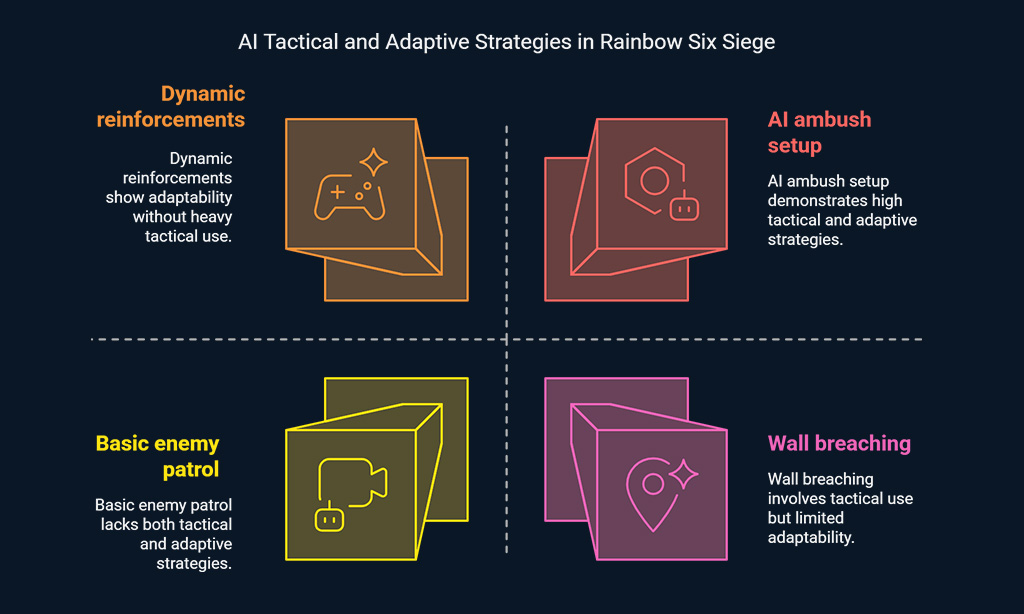Video games have evolved significantly over the years, with one of the most impressive advancements being the development of Artificial Intelligence (AI).
While early games relied on simple AI routines, modern AI systems are far more sophisticated, capable of creating dynamic and unpredictable challenges that truly test a player’s abilities. From strategy games to first-person shooters, AI opponents have become essential to crafting immersive and engaging experiences.
Games with the best AI opponents that will destroy you offer more than just a challenge; they redefine how we engage with video games. These games force players to think critically, adapt on the fly, and outsmart their enemies, whether they’re facing off in an intense firefight or a complex strategic battle.
In this article, we’ll explore 10 such games where the AI is so advanced that it will push your skills, reflexes, and patience to their limits.
Criteria for Choosing Games with the Best AI Opponents
When it comes to choosing the games with the best AI opponents, certain characteristics are essential. The AI should not only be a worthy adversary but also engage with the player in a way that is unpredictable, intelligent, and adaptable. Here’s a breakdown of the key criteria we used to select these games:
AI Complexity and Strategy
A good AI is more than just a series of scripted behaviors. The best AI opponents can analyze the player’s strategy, adapt to their actions, and employ complex tactics to challenge the player. In some games, the AI will even learn from your playstyle, making each encounter unique.
For example, in games like XCOM 2, the AI uses sophisticated algorithms to predict and counter your moves, ensuring that you can’t simply rely on the same tactics over and over again. The AI’s ability to plan and execute strategic decisions forces players to stay sharp and think multiple steps ahead.
Difficulty Levels and Player Challenge
The best AI should create a challenging yet fair experience. These games often offer multiple difficulty settings, but the AI’s response to the player should remain dynamic. Games with AI opponents that will destroy you don’t just make enemies harder to kill—they make them smarter and more strategic.
Take Dark Souls III, for example. Its infamous difficulty is not just about enemy health and damage; the AI in this game learns from the player’s actions and adapts accordingly. This means that the player has to continually adjust their strategy, making each fight an evolving challenge.
Top 10 Games with the Best AI Opponents That Will Destroy You
Now that we’ve set the stage for understanding what makes the best AI opponents, let’s dive into the top 10 games where AI challenges players like no other. These games feature some of the most sophisticated and ruthless AI, ensuring that every encounter feels like a real battle for survival.
1. XCOM 2
XCOM 2 is one of the most renowned strategy games, and its AI is a huge reason why. The enemy factions in XCOM 2 are not just a set of enemies with predictable attack patterns. Instead, the AI learns from your actions, adapts, and devises new strategies to overcome your defenses. The aliens will use flanking, ambushing, and suppressing fire to outmaneuver your soldiers.
The AI is designed to make decisions based on the situation, considering factors like your squad’s position, available cover, and even the terrain itself. This makes every battle feel dynamic and forces players to keep refining their strategies.
Key Features of XCOM 2 AI:
| AI Behavior | Description |
| Adaptive Tactics | The AI adjusts its strategy depending on the player’s actions, such as moving troops to flanking positions or calling for reinforcements. |
| Group Coordination | Enemies will often work together, using the environment to their advantage. This forces the player to be strategic about positioning and movement. |
| Difficulty Scaling | As difficulty increases, enemies become smarter and more aggressive, learning from the player’s previous actions. |
2. The Last of Us Part II
In The Last of Us Part II, AI plays a pivotal role in both combat and narrative immersion. The human and infected enemies are not just random, mindless enemies. They respond to sound cues, actively search for the player, and even work together to trap and surround you.
The game’s AI reacts dynamically to the player’s actions—if you sneak around, enemies may start to patrol more thoroughly. If you engage aggressively, the AI will become more cautious and use smarter tactics to respond.
In particular, the human enemies in The Last of Us Part II display complex behavior. They communicate with each other, coordinate attacks, and pursue you with relentless determination. This makes each encounter feel tense and unpredictable.
Notable AI Moments:
| AI Behavior | Description |
| Reacts to Sound | AI enemies can hear your movements, making stealth an essential element in avoiding detection. |
| Search and Pursue | If you hide, enemies will actively search for you and flush you out, forcing you to think on your feet. |
| Group Tactics | Human enemies often work together to trap the player, calling for reinforcements or flanking the player’s position. |
3. Dark Souls III
The Dark Souls series is notorious for its punishing difficulty, and Dark Souls III is no exception. The AI in this game is designed to be unpredictable, often taking a tactical approach to combat. Many of the game’s bosses and enemies have multiple attack patterns that can change depending on the player’s actions, requiring quick reflexes and a deep understanding of enemy behaviors.
The AI in Dark Souls III doesn’t just make enemies tougher—it creates a combat system where timing, positioning, and patience are essential. Bosses like Pontiff Sulyvahn or Slave Knight Gael demonstrate how the game’s AI can learn from the player’s movement and adapt accordingly.
AI Behavior in Boss Fights:
| Boss Name | AI Behavior | Player Strategy |
| Pontiff Sulyvahn | The boss has fast, aggressive attacks and switches between them rapidly, creating a constantly shifting battle. | Focus on dodging and learning the rhythm of the attacks to create openings. |
| Slave Knight Gael | Gael’s AI is relentless and adapts to the player’s style by using different types of attacks during the fight. | Use patience and counter-attacks, as Gael reacts strongly to aggressive play. |
4. F.E.A.R.
F.E.A.R. is a classic first-person shooter with advanced AI that heightens the horror experience. The game’s AI-controlled enemies use the environment to create ambushes, flank the player, and even communicate with each other to outsmart you. What sets F.E.A.R. apart is the psychological aspect of the AI—enemies stalk you through dark environments, making the experience both terrifying and challenging.
The game’s AI adapts to the player’s actions, creating tense scenarios where the player is always on edge, wondering where the next attack will come from.
Key Features of F.E.A.R. AI:
| AI Behavior | Description |
| Flanking and Ambushing | Enemies often work together to corner and ambush the player, using the environment to their advantage. |
| Intelligent Teamwork | Enemies communicate and coordinate, increasing the challenge as players are forced to deal with multiple threats. |
| Psychological Tactics | Enemies use darkness and stealth to create tension, making players feel as though they are always being hunted. |
5. Halo: Combat Evolved
Halo: Combat Evolved set a new standard for AI in first-person shooters, featuring enemies that use teamwork, strategy, and terrain to their advantage. The Covenant enemies, in particular, demonstrate impressive AI behaviors.
Grunts may retreat when overwhelmed, while Elites charge at you with brutal force. The AI soldiers don’t just stand and shoot—they move intelligently, provide cover fire, and use the environment for flanking.
What makes Halo‘s AI stand out is how it simulates real tactical combat. The AI enemies will often change their approach depending on whether they’re fighting from a distance or in close quarters.
Key Features of Halo AI:
| AI Behavior | Description |
| Tactical Movement | Enemies will flank, retreat, and work together to outsmart the player. |
| Adaptive Combat | Enemies change tactics based on the combat situation, such as using cover or retreating when outgunned. |
| Communication and Coordination | The AI regularly coordinates its attacks, making each encounter feel like a well-organized battle. |
6. Resident Evil 4
Resident Evil 4 is a survival horror game where the AI’s intelligence plays a critical role in building tension. The Ganados, the infected villagers, are relentless in their pursuit of the player. They move strategically, blocking escape routes, setting up traps, and attacking in groups. As you progress through the game, the AI becomes more aggressive and intelligent, requiring careful management of resources and tactics.
The AI in Resident Evil 4 learns from the player’s behavior, making each encounter feel increasingly dangerous as the game progresses.
AI Features in Resident Evil 4:
| AI Behavior | Description |
| Relentless Pursuit | Enemies pursue the player with determination, making it difficult to outrun or hide. |
| Tactical Group Attacks | The AI often attacks in groups, forcing the player to deal with multiple threats at once. |
| Dynamic Adaptation | The AI adjusts its approach based on the player’s combat style, becoming more aggressive in later stages. |
7. Tom Clancy’s Rainbow Six Siege
In Rainbow Six Siege, the AI opponents are highly tactical and reactive, which makes for some of the most intense firefights in modern first-person shooters.
The AI uses the environment to its advantage, breaching walls, deploying drones, and setting up ambushes. What makes the AI in Rainbow Six Siege stand out is its ability to predict and counter player strategies, making each encounter feel like a unique challenge.
Key Features of Rainbow Six Siege AI:
| AI Behavior | Description |
| Tactical Use of Environment | AI enemies breach walls, create choke points, and utilize traps to corner the player. |
| Adaptive Strategies | The AI adjusts its strategy based on player actions, making it difficult to predict. |
| Dynamic Reinforcements | Enemies will call for reinforcements and adapt their strategies in response to changing combat conditions. |
8. Hitman 3
In Hitman 3, the AI is incredibly sophisticated, allowing NPCs to react intelligently to your actions. Whether you’re sneaking past guards or performing a covert assassination, the AI tracks your every move. NPCs have their own routines, and they’ll notice unusual behavior and alert others. What sets Hitman 3 apart is how the AI reacts not only to your actions but also to the environment around them, making each mission a unique puzzle to solve.
AI Features in Hitman 3:
| AI Behavior | Description |
| Environmental Awareness | NPCs are aware of their surroundings and can notice when something is out of place. |
| Intelligent Surveillance | Guards and other NPCs will notice suspicious behavior and alert their superiors. |
| Dynamic Reactions | The AI adapts to your strategy, making stealth a more difficult and rewarding challenge. |
9. Civilization VI
In Civilization VI, the AI plays a crucial role in shaping the game’s strategy. Each civilization has its own AI-driven personality, which dictates its diplomatic, military, and economic decisions. The AI adapts to the player’s actions, forging alliances, declaring wars, and pursuing victory conditions based on the player’s progress.
Features of Civilization VI AI:
| AI Behavior | Description |
| Personality-driven Actions | Each AI has a distinct personality, influencing its diplomatic and military decisions. |
| Dynamic Diplomacy | AI civilizations adjust their alliances and rivalries based on player actions and game progress. |
| Strategic Pursuits | The AI pursues different victory conditions (military, science, culture) based on the player’s position. |
10. The Witcher 3: Wild Hunt
In The Witcher 3, the AI governs everything from the monster hunts to human combat. The game’s monsters adapt to your combat style, making battles dynamic and complex. For example, some monsters will use elemental attacks to counter your defenses, while others will employ guerrilla tactics, hiding in shadows and striking at opportune moments.
Memorable AI Opponents in The Witcher 3:
| AI Behavior | Description |
| Elemental Tactics | Monsters use the environment to their advantage, such as casting fire spells near dry grass to increase damage. |
| Adaptive Combat | Enemies change their attack patterns based on player actions, making it hard to predict their moves. |
| Tactical Ambushes | Some enemies wait for the right moment to strike, forcing the player to be vigilant and constantly adapt. |
Wrap Up: Embrace the Challenge of AI Opponents
The games listed above showcase the true potential of AI in modern gaming. These AI opponents do more than just create challenges—they enrich the narrative, enhance immersion, and ensure that players are always on their toes.
Whether you’re exploring strategic depths, engaging in intense firefights, or solving complex puzzles, these AI systems will push you to your limits, ensuring that every victory is hard-earned and every defeat teaches you something new.
Each of these games offers a different flavor of AI-driven challenge, providing something for every type of gamer. So, if you’re looking to truly test your skills and intellect, these games will provide endless opportunities to do so.












































